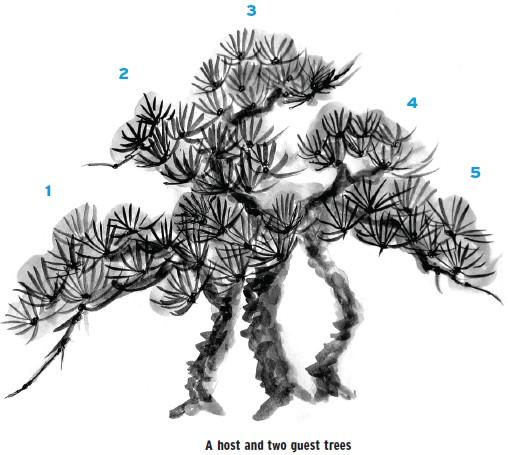Read Chinese Brush Painting Online
Authors: Caroline Self,Susan Self
Chinese Brush Painting (19 page)
7.
To the left and slightly below the wheel, make a dot for the next wheel. Make strokes toward the dot. They should overlap slightly as they go diagonally toward the left and downward.
8.
Do five of these wheels, as shown.

Painting the Full Pine Tree
Now that you have tried out three ways to make pine tree trunks, choose one that you want to use to paint a weather-beaten tree.

1.
Load the brush as described for the trunk method you want to use.
2.
Start at the left bottom of the page and paint the trunk upward as in the example, using your chosen method. The trunk should move a longer distance to the right, then shorter to the left, then even shorter to the right, and end with a very narrow stroke to the left. This makes a more interesting tree than a straight, vertical one.
3.
Add the darker bark scales.
4.
Plan the placement of clusters of needles:
Cluster 1.
A cluster sloping to the right and downward low down on the right side of the trunk.

Cluster 2.
A cluster going downward and to the left higher on the trunk on the left side. These two large clusters are the main green parts of the tree.

Cluster 3.
A cluster sloping to the left and downward.

Cluster 4.
A cluster that will cover the top of the tree, then slope to the right and downward.

Cluster 5.
A small cluster at the bend in the trunk.

5.
Paint in the clusters you have planned as you did in the wheels exercise.
6.
Observe where the branches might connect from the bottom of each cluster to the tree trunk. The connections are made by using the press-and-lift stroke.
7.
To paint the branches, load a small brush with dark paint. Make a press stroke on the trunk, lift slightly, drag, and press, lifting to trail off in a thin stroke under the bottom of the cluster. Where the branch connects to the trunk, the press stroke is heavy. Near the top of the tree, the branch stroke is smaller, but it still makes a thin line under the cluster.

8.
To finish off the tree, use light paint on the small brush and stroke a half circle of paint like a gray cloud around each wheel in the cluster. This holds the cluster together as a unit.
If you did a good job painting pine on newsprint, try doing it on rice paper. Remember to use the smooth side of the rice paper so that your pine needles do not blur.

Painting Tree Arrangements
Trees are sometimes painted in groups, since that is the way they usually grow. When painting more than one tree, a common approach is to place a large, dominant tree as a host and smaller ones around it as its guests, which are less important. To make the arrangement of a host and two guest trees, decide the type of trunks you prefer.

Painting Trunks for a Tree Group
1.
Load the large brush as described for the trunk method you want to use.
2.
Left guest tree: trunk and branch 1.
Start at the bottom at the left and press, drag, and press with the brush, sloping the trunk slightly to the left for a few inches, and stop. This will be the left guest.

